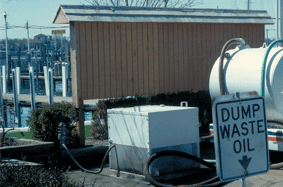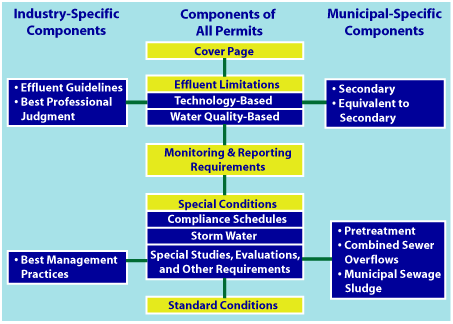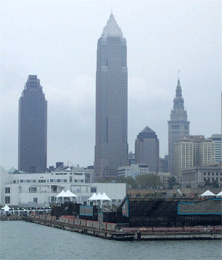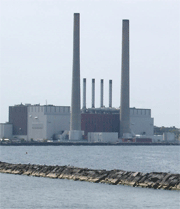Supplemental Module: NPDES Permit Program
This module provides an overview of the regulatory program—established under the Clean Water Act (CWA)—that authorizes the issuing of permits to control the discharge of pollutants from point sources into waters covered by a State or Tribe’s water quality standards. Since its introduction in 1972, significant improvement in the Nation’s water quality has been attributed to implementation of the National Pollutant Discharge Elimination System (NPDES) permit program.
In particular, this module provides answers to the following:
- Who issues NPDES permits and under what authority?
- What types of NPDES permits can be issued under the program?
- What steps are involved in developing an NPDES permit?
At the end of the module is a brief quiz intended to touch on aspects of the NPDES permit program. The topic is further examined in the classroom session of this module.
This module's main pages and brief quiz at the end take about 30 minutes to complete.
Point Source Control
A fundamental consideration for achieving CWA goals is the ability to control sources of pollutants that may be impairing or threatening the quality of navigable waters. In many jurisdictions, the discharge of pollutants from point sources is a significant factor to address when managing the condition of water bodies.
Pollutant discharges from point sources are controlled through the NPDES permit program. That is, the CWA prohibits the discharging of pollutants from a point source into a "water of the United States" unless the operation has been granted an NPDES permit that explicitly allows discharges by establishing:
- What and how much of a pollutant can be discharged into a receiving water.
- What monitoring and reporting on discharges are required.
- Other conditions as needed to carry out the intent of the CWA.
Resource. EPA’s comprehensive regulations that implement the NPDES program are at 40 CFR Part 122.
Learn More. Definitions of three key terms for the NPDES permit program. Proceed to the Learn More Topic.
Permitting Authority
Most States have been authorized by EPA under Section 402 of the CWA to issue NPDES permits for point source discharges. The Agency retains an oversight role by providing guidance and, in some instances, review of proposed permits. (Sec. 123) As with States, a Tribe (or a Territory) can also be authorized to implement the NPDES permit program in its jurisdiction if it can demonstrate that it meets the legal and programmatic requirements for program authorization established in the CWA.
In jurisdictions where the Agency has not authorized a State to issue NPDES permits, the EPA Region serves as the permitting authority, carrying out functions that include:
- Issuing permits.
- Conducting compliance and monitoring activities.
- Enforcing the requirements of the permit.
Resource. View a list of program authorization status by jurisdiction.
Types of Permits
An NPDES permit can be written to address discharges either from an individual point source or from a number of similar dischargers.

NPDES Individual Permit
The permitting authority writes an individual permit to address point source-specific conditions such as effluent limitations, management practices, and monitoring and reporting. The more complex the point source discharge, the more likely an individual permit is required.
For example, ACME Inc. has process wastewater that it wants to discharge to Pristine Creek. ACME submits a permit application to the State permitting authority that describes its operation and wastewater discharge. After reviewing ACME’s application and assessing the unique characteristics of the facility’s effluent, the State crafts and issues a permit that establishes facility-specific limits on pollutants of concern that ACME can discharged to Pristine Creek.
NPDES General Permit
The permitting authority writes a general permit after determining that a set of conditions regarding discharges (e.g., limits and monitoring requirements) would be applicable to a number of similar point sources in the same geographic area (e.g., facilities within a watershed that are operating similar processes). The NPDES regulations specify that the permitting authority must define the applicable geographical area and types of point sources in a general permit. (122.28)
After a general permit is issued, dischargers that think they meet the permit’s criteria can request coverage under the permit by submitting a Notice of Intent (as required by the permit) to the permitting authority.
Categories of Permits
EPA groups NPDES permits into two categories based broadly on the type of point source:
- Publicly owned treatment works (POTW). Treatment works that are owned by a State/Tribe or municipality. This includes devices and systems used in the storage, treatment, recycling, and reclamation of municipal sewage or industrial wastes of a liquid nature.
- POTWs can treat municipal sewage, industrial wastes, or a combination of the two.
- Non-publicly owned treatment works (non-POTW). All other facilities are non-POTWs and are often referred to as “non-municipals” or “industrials.”
- Industrials could include privately owned treatment works, water treatment plants, concentrated animal feeding operations (CAFOs), or any manufacturing or commercial activity.
EPA divides these two categories further between major and minor facilities—a distinction that was established during early implementation of the NPDES program to help prioritize the issuing of permits.
- Major POTWs include:
- Treatment works with design flows greater than 1 million gallons/day (MGD).
- Other treatment works given this designation (i.e., the Regional administrator has done so, in consultation with the State/Tribal permitting authority).
- Major non-POTWs include:
- Treatment works that score 80 or more points on the NPDES Permit Rating Worksheet.
- Other treatment works given this designation (i.e., the Regional administrator has done so, in consultation with the State/Tribal permitting authority).
- Minor POTWs/non-POTWS include:
- All other dischargers.
Permit Components
While EPA Regions and States may use differing formats, an NPDES permit generally includes the components presented in the graphic below. The same components are included regardless of whether it is an individual or a general permit.

Key Considerations
An NPDES permitting authority establishes the “effluent limits” of an NPDES permit based on two separate and unique approaches established in the CWA. The limits based on these approaches are referred to as:
- Technology-based effluent limits. Limits on pollutants of concern in discharges that have been established as being achievable by using available technology.
and
- Water quality-based effluent limits. Further limits on discharges of pollutants that may be necessary if the limits achievable using the available technology are not sufficient to prevent impacts from discharges into the receiving waters in regard to compliance with the State/Tribe’s water quality standards.
Technology-based effluent limits are required under the regulation as the “minimum level of control that must be imposed” in an NPDES permit. (Sec. 125.3) EPA establishes national technology-based standards for municipal dischargers and for various categories of non-municipal facilities. The standards and guidelines are based on the performance of actual treatment systems or other pollutant control technologies, such as process controls or material substitution. By not being site specific, the standards and guidance put all facilities within an identified category on an equal footing.
Key Point. A central concept built into the Act is that as technology improves, dischargers will move toward the goal of zero discharge of pollutants. Thus, technology-based effluent limits have their foundation in the CWA’s “zero-discharge” performance goal.
Resource. Linked listing of EPA-promulgated effluent standards and guidelines, sorted alphabetically by industry category.
Illustration. View a high-level diagram of the process for developing effluent limits. Proceed to the Illustration.
Technology-Based Determination
When a State or Tribe includes a technology-based limit in an NPDES permit, it is a performance standard only and the permitting authority generally cannot require the use of a particular technology to achieve the limit. Instead, it is left to the discharger to decide what approach it will take—the use of a particular technology or the implementation of pollution abatement—to comply with the permit requirements.
Key Point. Although the national standards and guidelines for the technology-based approach are promulgated in the NPDES program regulations, they are not “self-implementing.” For this reason, permit writers need to properly identify and apply the appropriate standards and guidelines by calculating and incorporating the technology-based effluent limits (TBELs) into NPDES permits.
Where national effluent limitation standards or guidelines are not available, permit writers can establish technology-based limits on a case-by-case basis using best professional judgment (BPJ).
Water Quality-Based Determination
In contrast to making the determination about technology-based effluent limits, when the State/Tribal permit writer moves on to consideration of water quality-based limits, the assessment becomes site specific. That is, potential impacts on the actual receiving waters of the discharge must be assessed in regard to the jurisdiction’s relevant water quality standards.
Key Point. Water quality-based effluent limits that are established in an NPDES permit apply at the discharge point, generally referred to as the “end of the pipe.” In contrast, water quality standards apply to an entire water body or segment. Thus, as necessary based on an analysis of the impact of pollutants on a receiving water, the permit writer needs to be able to translate the State/Tribe’s water quality standards into water quality-based effluent limits
The bases for translating water quality standards to effluent limits are the water quality criteria in the State/Tribe’s water quality standards. Water quality criteria are typically expressed using a magnitude, duration, and frequency that differ from the averaging periods for effluent limits.
| Water Quality Criteria | Effluent Limits |
|---|---|
Apply in the receiving water and could include:
|
Apply at “end of the pipe” and include:
|
| For example: An acute aquatic life criterion might be expressed as a magnitude of 10 ug/L, for a duration not to exceed 1 hour, at a frequency not to recur more than once in 3 years. | For example: 1 mg/L, to be determined over a specified averaging period, such as a daily maximum or a monthly average. |
Thus, when establishing effluent limits, the NPDES permit writer needs to follow a procedure that accounts for both the physical and chemical interactions between the effluent and the receiving water. In addition, the procedure must take into account the varying units of expression between the criteria in the water quality standards and the effluent limit to be included in the permit.
WQBELs Process
EPA has identified the following steps to assess the need for water quality-based effluent limits (WQBELs) and to then establish the limits as necessary based on the assessment:
Step 1. Identify applicable water quality standards.
Step 2. Characterize the effluent and receiving water.
Step 3. Determine the need for parameter-specific WQBELs.
Step 4. Calculate parameter-specific WQBELs.
Following these steps will enable States/Tribes to implement water quality standards in NPDES permits based on:
- Knowing the current water quality standards, including any changes.
- Being familiar with water quality standards implementation policies.
- Using procedures adopted by the permitting authority to establish limitations that are as stringent as necessary to attain the State/Tribe’s water quality standards.
The CWA requires effluent limits in NPDES permits that will ensure compliance with water quality standards. (CWA Section 301(b)(1)(C)) These limits are generally referred to as WQBELs.
This section of the module considers the four-step process in more detail.
Step 1: Identify WQSs

Establishing WQBELs: Step 1—Identify Applicable Water Quality Standards
To get the WQBELs assessment process under way, the State/Tribal permit writer should identify the relevant water quality standards and understand their applicability to the specific receiving water of the discharge being assessed. In particular, the permit writer should understand the forms of expression for the relevant water quality criteria (i.e., numeric and/or narrative water quality criteria).
Key Point. The permit writer may need to consult with the State/Tribe’s specialists on water quality standards to fully understand the jurisdiction’s intended application of the water quality criteria. (Note that a module in the Key Concepts section of this online training provides an introduction to criteria development.)
The permit writer should also be prepared to follow any implementation policies or guidance that the State/Tribe has included in its water quality standards; for instance, to address such considerations as dilution and mixing zones.
Step 2: Assess Concentration
Establishing WQBELs: Step 2—Characterize the Effluent & Receiving Water
This next step in assessing the need for water quality-based effluent limits involves a sequence of four tasks, which are listed below and described in the pages that follow:
- Identify pollutants of concern in the effluent.
- Establish whether dilution/mixing of effluent in receiving waters is allowed by the State/Tribe’s water quality standards.
- Identify critical conditions for effluent and receiving water modeling.
- Establish the appropriate dilution allowance or mixing zone for each pollutant of concern.
Pollutants of Concern
Characterizing the Effluent & Receiving Water: Identify Pollutants of Concern
State/Tribal authorities typically identify a pollutant of concern as any pollutant that falls into one of the following categories:
- Pollutants with an applicable technology-based effluent limit (TBEL). Thus, if the permit writer has already developed a TBEL for a particular pollutant, then he/she has to consider the pollutant a “concern” and determine whether the TBEL is sufficiently protective of water quality.
- Pollutants with a WLA from a TMDL or watershed analysis. Thus, if the total maximum daily load (TMDL) developers assigned a waste load allocation (WLA ) to a point source, then clearly it is of “concern” and the permit writer must ensure that the TMDL WLA is implemented through the NPDES permit.
- Pollutants identified as needing WQBELs in the previous permit. Thus, if this is a permit reissuance, the permit writer should reassess the need for water quality-based effluent limits for any pollutants that were regulated in the current permit.
- Pollutants identified as present in the effluent through monitoring. Thus, if the permit application or other effluent data indicate that a pollutant is present, then the permit writer should assess whether that pollutant could adversely affect water quality.
- Pollutants that are otherwise expected to be present in the discharge. In some cases, the permit writer may not have effluent data available (e.g., a new facility proposing to discharge). The permit writer may be able to establish that a pollutant is likely to be present in the effluent, based solely on the nature of the operation.
Dilution/Mixing
Characterizing the Effluent & Receiving Water: Establish Whether Dilution/Mixing Is Allowed
With the pollutants of concern in mind, the State/Tribal authority must then look to the water quality standards to see whether the permit can be written to allow for dilution/mixing of the effluent in the receiving water, either at the discharge point or in a mixing zone for the relevant pollutant at issue.
Key Point. Under the CWA, States/Tribes have the discretion to decide whether to include consideration of effluent dilution/mixing as part of their water quality standards. (Sec. 122.44(d)(1)(ii)) Where a States/Tribe’s water quality standards allow the consideration of dilution/mixing for a given pollutant or category of pollutants, the State/Tribe should identify the procedures and conditions under which mixing is allowed. When specific provisions are not written into the standards or implementing procedures, the permit writer may have to rely on existing guidance or practices to account for the mixing analysis.
Critical Conditions
If the State/Tribal water quality standards allow for consideration of dilution/mixing, then the permit writer needs to select an appropriate water quality model for predicting the impact of the effluent in terms of the receiving water’s assimilative capacity.
Since the majority of such analytical situations involves a single set of conditions for projecting the effluent’s impact, often the permit writer may use a steady-state water quality model.
Key Point. Because a steady-state water quality model is run on a single set of conditions, those conditions should be the critical conditions for protection of the receiving water.
Critical conditions generally fall into the following framework:
- Effluent critical conditions
- Effluent flow
- Effluent pollutant concentrations (i.e., for pollutants of concern)
- Receiving water critical conditions
- Receiving water flow (if applicable)
- Background pollutant concentrations (i.e., for pollutants of concern)
- Other characteristics of the receiving water (e.g., temperature, pH, reaction rates)
Key Point. A State/Tribe’s water quality standards (or permitting procedures) should identify the appropriate critical conditions. If not, the permit writer should look at other permits and follow past practice.
Learn More. Further explanation based on the critical condition for flow in a receiving water that is a river or stream. Proceed to the Learn More Topic.
Dilution/Mixing Allowance
Characterizing the Effluent & Receiving Water: Establish Allowable Dilution/Mixing
Where dilution/mixing is allowed, often a determination can be made about whether rapid and complete mixing of the effluent will occur in the receiving water, such that all applicable criteria for the pollutant of concern will be met almost immediately at the discharge location in the receiving water. This type of mixing would be expected for so-called effluent-dominated streams or where mixing is mechanically induced using a diffuser.
For situations where dilution is not immediate, the State/Tribe’s water quality standards may allow for mixing zones. A mixing zone is a limited area near the discharge point where the pollutant criteria can be exceeded until more complete mixing of the effluent is attained, as long as toxic conditions are prevented and the designated use of the water body as a whole is not impaired as a result.
Key Point. Where water quality standards do not allow for consideration of dilution/mixing, water quality criteria must be attained at the effluent’s point of discharge (end of pipe).
Learn More. Situations in which the permit writer might assume that water quality criteria should be attained at the point of discharge, even though consideration of dilution/mixing has been included in the water quality standards. Proceed to the Learn More Topic.
Step 3: Establish Need
Establishing WQBELs: Step 3—Determine the Need for Parameter-Specific WQBELs
This step in assessing the need for water quality-based effluent limits involves running the model (or models, as necessary) using inputs for the critical conditions and the dilution/mixing allowances identified in the preceding step.
- If: The model output predicts that discharges could result in concentrations of pollutants of concern in the receiving water that exceed applicable criteria in the State/Tribe’s water quality standards,
- Then: A “reasonable potential” for exceedance has been established and water quality-based effluent limits must be written into the permit.
Key Point. The so-called Reasonable Potential Test for determining whether WQBELs must be included in a permit is based on the regulation, which states: “Limitations must control all pollutants or pollutant parameters (either conventional, nonconventional, or toxic pollutants) which the Director determines are or may be discharged at a level which will cause, have the reasonable potential to cause, or contribute to an excursion above any State water quality standard.” (122.44(d)(1)(i))
Resource. Details on the methodology for calculating “reasonable potential” are presented in EPA’s Technical Support Document for Water Quality-Based Toxics Control (March 1991). The methodology focuses on projecting maximum expected value (i.e., the highest concentration that would be expected from a point source discharge if the effluent were monitored continuously for a very long time). (The link for downloading the document is TSD document.
Key Point. In the “fact sheet” that accompanies most permits, the permit writer should document the need for any WQBELs by presenting relevant data and assumptions.
Step 4: Calculate Limits
Establishing WQBELs: Step 4—Calculate Parameter-Specific WQBELs
If the assessment steps in the four-step sequence establish the need for a water quality-based effluent limit for a pollution of concern, then the permit writer will need to calculate a water quality-based effluent limit that is fully protective of the applicable water quality standards.
The first task in this process is to use the water quality model to establish a waste load allocation (WLA), which represents the maximum allowable pollutant concentration in the effluent that, after accounting for allowable dilution/mixing, will not cause an exceedance of the instream water quality criterion.
Once a WLA is established for each of the applicable criteria, the permit writer would use the mathematical approach provided in EPA’s Technical Support Document for Water Quality-Based Toxics Control—or other approved State/Tribal implementation procedures—for calculating the average monthly limit (AML) and maximum daily limit (MDL). These WQBELs establish performance expectations that should ensure that the WLA is not exceeded.
Resource. The methodology for calculating a point source-specific WLA is presented in EPA’s Technical Support Document for Water Quality-Based Toxics Control (March 1991).
Resource. EPA provides classroom training on NPDES permit writing. EPA’s NPDES Permit Writers' Training Course website provides date and location information. PowerPoint presentations for the classroom sessions are also available on the website.
Resource. See also EPA’s NPDES Permit Writers Management Tools webpage.
Summary
- The NPDES permit program authorizes the issuance of permits to control the discharge of pollutants from point sources into waters of the United States. Most States have been authorized by EPA under Section 402 of the CWA to issue NPDES permits for point source discharges. The Agency retains an oversight role by providing guidance and, in some instances, review of proposed permits. A Tribe (or a Territory) can also be authorized to implement the NPDES permit program in its jurisdiction.
- Technology-based effluent limits (TBELs) are required under the regulation as the “minimum level of control that must be imposed” in an NPDES permit. The TBELs are intended to implement one of the central concepts of the Clean Water Act—namely, the goal of zero discharge of pollutants.
- Water quality-based effluent limits (WQBELs) may also be necessary if the TBELs are not sufficiently protective of the State/Tribe’s water quality criteria.
Quiz
To complete your review of the topic in this module, please take the following brief quiz.
Answer each of the questions below
Disclaimer: This online course presentation and any associated links have been prepared by EPA staff for informational purposes only. Their sole purpose is to make available training online from recent Water Quality Standards Academy classroom courses. As such, this online course and any associated links are not binding on EPA or the public and have no legal effect. They do not constitute an EPA statute, regulation or other requirement and do not substitute for such authorities. In addition, the course and any associated links have not been reviewed or endorsed by EPA management. Thus, they are not intended or written as official statements of EPA's scientific views, policies, guidance, or requirements and cannot be used or cited as evidence of EPA's position on any matter.

